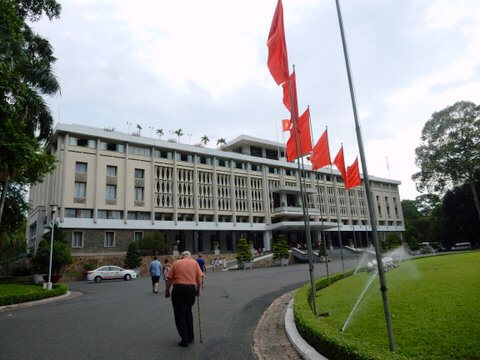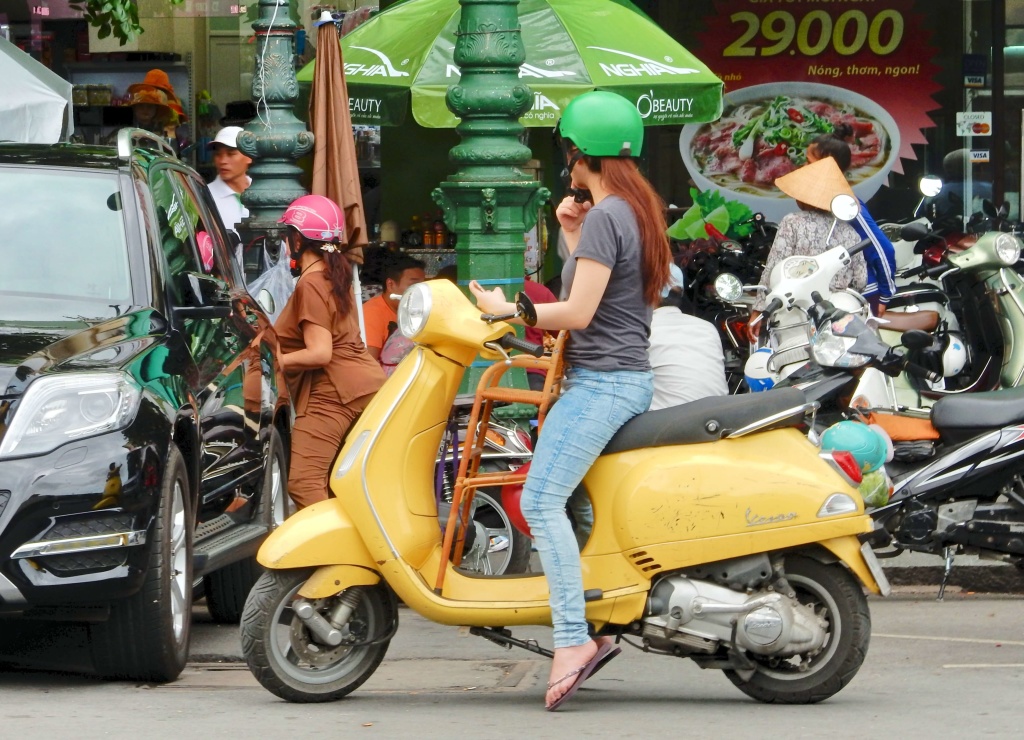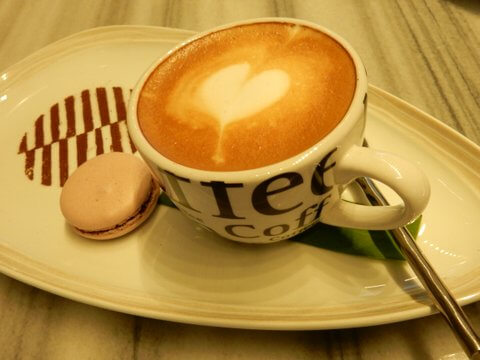By Linda Gasparello
In Ho Chi Minh City, the steeples of Notre Dame Cathedral and other French colonial-period churches no longer dominate the skyline. Tower cranes are everywhere as scores of high-rise buildings are going up in this city of 8 million, which is widely still called Saigon.
This city is a hive for the young – 60 percent of Vietnam’s population is under 30, and 85 percent is under 40. Educational attainment is rising fast. In Ho Chi Minh City, there are more than 80 universities.
“Young Vietnamese are eager to learn,” said Duc Anh, one of the city’s young entrepreneurs. And earn.
Wearing shiny helmets, cowl scarves pulled up to their noses, jackets and gloves, young Vietnamese swarm the streets on their motorbikes.
Those with dash and cash head, for example, to the Vincom Center, a twin-towered, glassy mega mall in District 1, the city’s center. They hang out in the district’s burgeoning home-grown coffee chains with European-cafe (the French introduced coffee to Vietnam in 1857) ambiance, including Phuc Long Coffee and Startup Coffee. And they club the night away.
But modernization hasn’t come to all of the city’s 24 districts (19 urban and five rural) at a high-octane rate. Traditional culture is parked everywhere from the streets lined with shops carrying just one type of product, to the pungent food stalls in the Binh Tay Market in Cholon, the city’s huge Chinatown, to The Jade Emperor Pagoda, a multi-faith temple, built by the Cantonese in 1909, where turtles swim in the fetid courtyard pools and people pray in a fog of incense smoke.
This diary will meander from Ho Chi Minh City to Nha Trang, a buzzy seaside town, also the capital of Khanh Hoa Province, on the south central coast of Vietnam.
Landmark Meeting
In July, I traveled to Vietnam with my husband, Llewellyn King. It was our second trip to the country in six months, and in a year that marks two important anniversaries: the 40th of the end of the war with the United States, and the 20th of the normalization of diplomatic relations.
During our trip, a milestone in Vietnam-U.S. relations was in the making: Nguyen Phu Trong, general secretary of the Vietnam Communist Party, met with President Obama at the White House.
“As you heard, I got an invitation to Vietnam. And I think this is indicative of the remarkable progress that’s taken place in the relationship between our two countries over the last 20 years,” Obama told reporters in the Oval Office, following his meeting with Trong on July 7.
“Twenty years is a long period of one’s lifetime. Yet, it is merely a fleeting moment in the long history of relations between nations,” Pham Binh Minh, deputy prime minister and foreign minister, wrote for a news site of the state-run Vietnam News Agency. “Few people could have imagined that Vietnam and the United States would make such great strides in their bilateral ties after two decades of normalized relations.”
Since May 2014, when a fierce fight over sovereignty broke out between communist neighbors Vietnam and China, causing relations to plummet to their worst level in three decades, those strides have become more vigorous in defense. In October that year, the United States decided to partially lift its ban on lethal weapons sales to Vietnam. And three months ago, the two countries announced a Joint Vision Statement to increase defense ties, bolstering the comprehensive political and strategic partnership established in 2013.
Trade between the Vietnam and the United States has grown by leaps and bounds. “From a modest figure of $400 million in 1994, bilateral trade has increased 90-fold to $36.3 billion in 2014. With $30.6 billion in exports to the United States in 2014, Vietnam became ASEAN’s No. 1 exporter to the U.S. market: Vietnam even surpassed India and joined the list of top 10 net exporters to the world’s largest consumer market,” Minh wrote in his July 7 article.
Currently, the United States is the sixth-largest investor in Vietnam, with direct investment of $7 billion, reaching $9 billion with the addition of investment via a third country. In two or three years, the United States will become the top investor in Vietnam, a place now held by South Korea, predicts Matthew Daley, chairman of the U.S.-ASEAN Business Council. In early May, the council sponsored a group of 23 U.S. businesses on a visit to Vietnam – the largest-ever U.S. business group trip to the country.
It won’t be long before the “Made in China” labels in your clothes and other products will be replaced with “Made in Vietnam” labels. Not long at all: the Chico’s brand sweater I’m wearing has that label.
Crisp Currency
The Vietnamese don’t like creased or crumpled currency. I found this out when I tried to change a $20 bill at the Pullman Saigon Centre, a five-star hotel, in Ho Chi Minh City.
I handed Giang, a front desk clerk, a neatly folded $20 bill, and asked her to exchange it for dong. She handed it right back to me with two hands, saying, “We cannot change it; only new bills. It is a law since 2006.”
By new, she meant hot off the U.S. Mint presses. “Money is money; crisp or crumpled,” I protested.
“No,” she said, “In Vietnam it is not. And so many visitors here are sad when I cannot change their money.” And mad, too, I thought.
I’m not sure there is such a law, but there is a tradition of crisp currency in Vietnam.
“In general people prefer notes to be shiny, new, crisp and unfolded. Traditionally money is given in the New Year, at weddings and other family occasions. Fresh, new notes are considered ‘lucky,’ while grubby, crumpled, soggy notes are very much frowned upon,” according to Jonny Platt, a Briton who has lived a decade in Ho Chi Minh City and writes the Vietnam Travel blog.
“When paying for goods or services, it is polite to straighten the notes and to hand them to a vendor with two hands, making eye contact as you do so,” Platt advises in his blog.
Sweet Thy
When in Ho Chi Minh City, get a guide. That’s my advice.
Mind you, as a lifelong traveler, I love meandering in a city. But when I’ve toured a city with a good guide, it’s really paid off.
Hiring one can be a crapshoot, but my husband and I lucked out twice in this buzzy southern city.
We took two city tours, morning and afternoon, offered by Saigontourist, a state-owned holding company with investments in the hospitality (including the Pullman) and tourism industries. Small and medium-sized, independent tour operators are cropping up, but they’re up against a government giant: I was told, for example, that Saigontourist is one of two companies allowed to provide tours to the cruise ships making calls in Vietnam’s southern ports, which are becoming industry hot spots.
Both guides may have been government employees, but they were anything but dull, especially our afternoon guide, Anh Thy. Indeed, the booking agent said, “You were very lucky. She was a history teacher. She is famous in Saigon.”
During our four-hour tour with Miss Thy (pronounced “tea”), we learned that she was a gifted anthropologist and comedian. Our tour included a visit to the Ben Thanh market; The Jade Emperor Pagoda; the Reunification Palace; and a cyclo ride in Cholon, the Chinatown that dominates the western part of the city.
On one street, Miss Thy pointed out a Fruit Shake shop that sells nuoc ma, sugar cane juice. “We like that drink. So sweet, you don’t have to sweeten it,” she said, adding, “Sugar-cane juice in Fruit Shake with many flavors becomes a high-class beverage in Vietnam.” It’s also a refreshing drink sold all over the country in lowlier stalls and carts.
Miss Thy gave us this food and beverage rule of thumb: Hanoi, located in the North, hot and salty; Hue, in the central part of the country, hot and spicy; Saigon, cold and sweet.
As for coffee, Vietnam is the world’s largest producer of Robusta coffee, a bean variety that coffee experts consider inferior to the Arabica type. But the Vietnamese don’t give a hill of ’em about that, and brewed Robusta is a top drink thanks to Vietnamese ingenuity, which you’ll see everywhere from their agricultural practices to exquisite handicrafts to major engineering projects, to the way millions of motorcyclists know where to buy gas in Saigon, where there are few gas stations — Hint: Look for an upturned brick on a sidewalk, and you’ll find a man with a gas can.
In Ho Chi Minh City and elsewhere in Vietnam, coffee is prepared using a small, metal drip filter. “In the South, we like our coffee cold and sweet with [condensed] milk.” If you crave an Americano or a cappuccino, you can order one at the proliferating European-style coffee shops, like the local My Life Coffee, or the Australian chain, Gloria Jean’s. And they often come – thanks to Vietnam’s French colonial past and current culinary trends – a macaron.
Another one of Miss Thy’s food and beverage rules of thumb: “We drink coffee in Saigon; in Hue, they drink coffee and tea; and in Hanoi, they drink tea, like the Chinese.”



